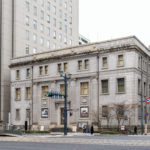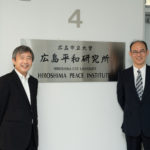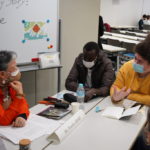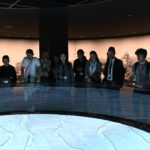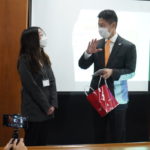II Hiroshima Reconstruction Planning
1 Hiroshima During and After the Atomic Bombing
On August 6, 1945 at 8:15 a.m., an atomic bomb exploded in the skies over Hiroshima. The atomic bomb had been developed, tested, and, for the first time in human history, dropped and detonated in the skies over a city where many people lived. Countless people died in the explosion, were injured, and became radiation victims. Even though time has passed, further illnesses still arise, and many people continue to suffer from aftereffects. At the same time, the bombing destroyed the city, including houses, shops, factories and public facilities as well as the public infrastructure, such as transportation and communication facilities and water and sewage systems.
According to Hiroshima Shisei Yoran: Fukko Dai Ichi Nen Go, Showa Nijusan Nen Ban (the Municipal Handbook of the City of Hiroshima, 1946the first year of the reconstruction edition) (published March 31, 1947), the Hiroshima Prefectural Police announced that its statistics showed that as of November 30, 1945, 55,000 buildings had been completely burned; 2,290 partially burned; 6,820 completely destroyed; and 3,750 partially destroyed. A further August 1946 investigation gives a breakdown of the building damages based on their distance from the hypocenter. The total number of buildings before the bombing was 76,317, and the number of the buildings that were more than half burnt or destroyed reached 70,147. These numbers differ depending on the source, but without doubt, over 90% of the city was destroyed.
In Nagasaki, though the bomb was not dropped on the city center, the bomb was a more powerful plutonium bomb and the damages extended to a wide area. Therefore, there were many casualties in Nagasaki as well, including heavily and slightly injured people. As for the figures of the building damages in Nagasaki, there were 1,494 buildings completely burned, 150 half-burned, 2,652 completely destroyed, and 5,291 half-destroyed. The ratio of half-damaged buildings was greater compared to that of Hiroshima, which indicates that the damages in Nagasaki extended to a wider area.
2 Exploration and Preparation of the Reconstruction Plan and Various Reconstruction Concepts
(1) Emergency Restoration
In order to return to some form of normalcy after the bombing, a restoration process was necessary. It was necessary to speedily restore transportation, electricity, and water by carrying out an emergency infrastructure restoration. It is said that the trains and streetcars were among the first services restored. Three days after the bombing, on August 9, one track between Koi and Nishi-temma was in operation once again as a result of the hard work put into the restoration and maintenance of the streetcar network. The Japanese National Railways Sanyo Line was also opened between Hiroshima and Yokogawa on August 8, and the Geibi Line opened on August 9.
However, due to the Makurazaki Typhoon in September and the heavy rain in October, the bridges that had been urgently repaired were again damaged or collapsed, and once again the living conditions of the citizens were greatly affected.
The main streets were first cleared of debris, just enough to let traffic flow again, and then the surface of the streets and the parapets of the bridges were repaired. The restoration of the Aioi Bridge is probably the most well-known picture (Photo 3-1). Restoration of the water system started by fixing leaks, but the overall restoration was not an easy work. Well water became very useful and many wells were dug in the city.
Emergency measures to restore war-damaged areas were implemented to rehabilitate the city. According to the Sensai Fukkoshi: Dai Nana Kan, Hiroshimashi (Record of War Damage Reconstruction, Vol. 7, Hiroshima City), “Emergency measures in the war-damaged areas started with clean-up operations in the relevant areas. The city reconstruction project was implemented and the city was divided into two areas with the City of Hiroshima in charge of the eastern part of the city and Hiroshima Prefecture in charge of the western part. The cleanup operation was also divided into two areas with the City responsible for the eastern part and the Prefecture for the western part.” The clean-up operations conducted with national government aid started in the fiscal year of 1946 and continued until 1949.
Metal was also collected as one of the emergency measures. The collected metal was then sold, and the revenue was pooled to be used for the reconstruction works of the war-damaged city. Funeral services for war victims were also necessary.
The water-supply system was heavily damaged, including the water-intake, water treatment, and water-supply facilities; but as water is essential for people’s lives, water pumps resumed operations four days after the bombing. Repairing the waterworks was an arduous task. It took a long time to repair the entire water system of the city, because water leaked and spouted at many places in the city. It is said that it took nine months to restore the water supply to the outskirts of the city. In the meantime, groundwater was hand-pumped at many places after the war.
The sewage system in Hiroshima was a confluence of rainwater and sewage systems. Drainage pumping stations, manhole covers and outlets had all been seriously damaged. Emergency repair work was conducted to discharge water, but heavy rains frequently caused floods. The situation gradually improved through efforts including the emergency restoration of the drainage pumping stations and the clean-up and maintenance of the sewer pipes.
Housing projects needed emergency measures; and mid to long-term perspectives were also necessary. The national government promoted building houses by mobilizing the Housing Corporation, which had functioned during the war. In Hiroshima, the planned site for Chuo Park in Moto-machi was turned into a large residential area, in which a total of 1,815 homes were constructed from 1945 to 1947, including 743 homes to provide shelters for winter, 1,038 municipal housing units, and 34 built by the prefecture for those returning to Japan. This emergency housing would later become a major problem when the city had to consider how to end the reconstruction projects.
(2) Reconstruction Proposals and Various Concepts
The reconstruction plan of the city was addressed by both Hiroshima Prefecture and the City of Hiroshima. Before the end of war, the prefectural government took the lead in formulating the city planning of the city of Hiroshima; but with the democratization after the war, the administrative authority was devolved to the City, which then took up the efforts itself.
The Reconstruction Bureau (Fukko Kyoku) was founded in the Hiroshima City Office on January 8, 1946, and Satoshi Nagashima, who was born in Chiba Prefecture and worked at Nagoya City Hall, was invited to act as the Director of the Reconstruction Bureau. At the same time, the Hiroshima City Reconstruction Council was established as an advisory body to the mayor, and the first meeting was held on February 25. In this meeting there was lively discussion and hopes were raised for the reconstruction efforts. Council minutes are collected in the Hiroshima Shinshi: Shiryo Hen II, Fukko Hen (History of Postwar Hiroshima: Resource Materials Vol. 2, Reconstruction), in which one can find a wide variety of information on its proceedings and decisions.
The person responsible for the foundation of the Hiroshima City Reconstruction Council was Mayor Shichiro Kihara. Senkichi Awaya was the mayor at the time of the bombing but was said to have been killed instantly by the blast. Kihara stepped in as mayor after being selected in September, 1945. Then in April 1947, in the first postwar public election, Shinzo Hamai, formerly a member of the Reconstruction Council, was elected mayor and would go on to handle many important municipal duties during the reconstruction period.
Numerous proposals were made by the Reconstruction Council. Outside of the Council too, a great number of ideas were proposed in newspapers and magazines and at various other fora. It can be said that the city planning of postwar Hiroshima was characterized by the vast number of ideas proposed.
The main ideas proposed in the immediate aftermath of the war were as follows: 1) the relocation of the city, 2) small city concepts, 3) ground elevation, 4) the concept of riverbank greenbelts, 5) Shigeru Watanabe’s proposal, 6) Sankichi Toge’s proposal, 7) Kenzo Tange’s proposal, 8) Miles Vaughn’s proposal, 9) Tam Derring’s proposal, 10) John D. Montgomery’s proposal, and 11) Stanley Archibald Jarvie’s proposal. These proposals were made in different ways. In some cases, many people were involved in drafting one proposal; and in other cases, many ideas were submitted by one person. When they are studied in detail, these plans and concepts included a variety of ideas, as they were not proposed in a consistent manner. The relocation of Hiroshima was proposed by Tomiko Kora and others (Figure 3-1). They proposed that the center of the blast in the city should be left just as is, and a new city should be built at a different location. As a plan it was a most impressive, striking proposal but this idea was not adopted due to various reasons. The ground elevation plan was proposed by Jujiro Matsuda and others, and was a revolutionary plan which proposed elevating the ground level of Hiroshima in the reconstruction plan, as the city had often suffered from floods. “Hiroshima in 1965,” proposed by Sankichi Toge, who won the essay competition, also garnered much attention.
Regarding the small city concepts, some assertively proposed that Hiroshima should be planned as a smaller city because they thought it was ideal for Hiroshima to be a small-sized city. Others proposed this idea from a more pessimistic point of view because they thought it was impossible for Hiroshima to become a big city again. In either case, at the time, many thought that Hiroshima was destined to be a small city after the atomic bombing.
These proposals were not only made by Japanese people but also by those from overseas, particularly by those from the United States and Australia. Among them, John D. Montgomery, Stanley Archibald Jarvie, Miles Vaughn, and Tam Derring stood out as most conspicuous. They all emphasized the importance of memorials and conservation, such as the preservation of the A-bomb Dome.
In this way, there were vast numbers of proposals, but only a few were adopted and implemented. The proposed greenbelts along the riverbanks were later realized, but most proposals were left untouched.
3 The Contents of the Initial Hiroshima Reconstruction Plan and its Operation Initiatives
(1) Process of the Legally Authorized Plan
Japan’s system of city planning has a unique process through which decisions on city planning were made in the form of legally authorized plans. This system was stipulated in the City Planning Act put into effect in 1919. According to this system, plans must be prepared as bills subject to review by the City Planning Commission of Hiroshima Prefecture. Once passed, it must go through the administrative procedures of the department acting as secretariat of Hiroshima Prefecture, and then be reviewed by the Ministry of Home Affairs. The Ministry of Home Affairs then made a final decision which was released as an official notice, thus completing the process. After the war, management of this process was shifted from the Ministry of Home Affairs to the War Damage Reconstruction Agency.
By 1940, there were roads planned through this city planning process. Starting in the early Showa period (1926-89), city planning projects had been implemented based on this process, and new roads were under construction. However, many of these projects were halted when Japan entered into the Second Sino-Japanese War, which then led to the Pacific War. The postwar reconstruction plans were based on this method.
After the war, in 1946, reconstruction plans were drafted by Hiroshima Prefecture and the City of Hiroshima, and a proposal was then sent to the War Damage Reconstruction Agency for adjustment. It was then discussed by the City Planning Commission of Hiroshima Prefecture, after which an official notice was issued by the Agency.
The first postwar reconstruction agenda item in Hiroshima was the “Hiroshima Reconstruction City Planning Road Decision” discussed at the 39th meeting of the Commission on September 16, 1946. After the Commission adopted the proposal as drafted, it was legally authorized when the War Damage Reconstruction Agency issued official notice No. 198 in its gazette on October 4.
In the discussion during the commission meeting, there was an explanation of how the “character of the city” was in relation to the planning of roads. This was included as part of the agenda item. At this stage in planning, key terms such as “City of peace,” “City of culture” and “hub city” were already discussed. The basic details of the plan summarized that “the plan is full of dignified ideas and pride; Hiroshima is a memorial city for world peace. The city must be reconstructed as an ideal city of culture, symbolizing world peace. The whole world is now watching Hiroshima.”
(2) Road Planning as Part of the Reconstruction
Printed and published in December 1946, the Hiroshima Reconstruction City Planning Map (Figure 3-2) is a comprehensive drawing of the reconstruction plan of Hiroshima City. The Planning Map of Road Network (Figure 3-3) extracts only the roads
from this drawing. At the 39th meeting of the City Planning Commission of Hiroshima Prefecture, the secretary-general Teizo Takeshige, Director of the City Planning Division of Hiroshima Prefecture, explained the meaning behind each of the main roads, according to a Hiroshima Shisei Yoran (Municipal Handbook of the City of Hiroshima) by saying the following:
“Main roads are not only for the convenience of city traffic, but also they serve as arteries to connect the city with satellite cities and surrounding areas as well. This plan must consider fundamentally improving Hiroshima, which has become a blank slate after it was reduced to ashes. The roads must connect Hiroshima to surrounding areas in the north, south, east and west; Hiroshima Station, a gateway of the land, must be connected with Ujina Port, a gateway of the sea; the site of the future airport with Hiroshima Station; and Hiroshima Station with the center of the city.”
In reality it was not planned out on a completely “blank slate” but rather followed some of the city’s past plans, which somewhat influenced the reconstruction plans.
In this manner, the reconstruction of roads started with the Hiroshima delta area. Multiple axes were running from north to south through large deltas, and on smaller deltas, one axis was running through the center. Streets running east-to-west had differing characteristics such as commercial and business streets, the national trunk road, and routes connecting industrial areas. In all, they made up a grid pattern with numerous special features built into the planning of the city. Using the prewar road plan as a base, they also adopted completely new routes. The map shows the accumulation of different plans in the history of Hiroshima. The most conspicuous routes were the Hijiyama-Kogo Line, a 100-meter wide road stretching east to west, and a road extending diagonally from Hiroshima Station towards Yoshijima. The former was known as the “100-meter road,” and was later officially named “Peace Boulevard.” To the south of this street, there was a plan to create another 100-meter road, the Desio-Kogo Line. Of this street, a total of about 6.1 kilometers in length, about 1.9 kilometers from Funairi-kawaguchi-cho to Minami-kanon-machi was to have a road of one-hundred meters in width. What happened to these wide streets will be explained later.
(3) Planning Parks and Green Areas as a Part of Reconstruction
Planning for parks and green areas was decided upon at the 40th meeting of the City Planning Commission of Hiroshima Prefecture on October 19, 1946. It was there that secretary-general Teizo Takeshige, Director of the City Planning Division of Hiroshima Prefecture, mentioned the international standards of park development. One can see that he wanted to raise the standards for the parks in Hiroshima as much as possible.
The Planning Map of Park Areas (Figure3-4) was also made based on the above-mentioned comprehensive drawing (Figure3-2), extracting only the planned areas for parks and green areas.
The plan consisted of three large parks (total area of 101.2 hectares)―Chuo Park, Nakajima Park, and Higashi Park―and four green areas (total area of 62.02 hectares), a cemetery (19.29 hectares), and 40 small parks (total area of 66.35 hectares). However, this did not include some of the existing parks, nor the small parks which were already planned as part of the land readjustment. Additionally, riverbank greenbelts were planned “in order to beautify the waterfront city.”
(4) Decisions on Land Readjustment Areas
There was, however, no guarantee for these plans on roads and parks to be implemented. In order to secure the necessary land, land readjustment had to be conducted. Decisions regarding land readjustment were discussed and adopted at the 39th City Planning Commission of Hiroshima Prefecture and issued as notice No. 199 on October 9, 1946 (Figure 3-5).
According to Hiroshima Shisei Yoran: Fukko Dai Ichi Nen Go, Showa Nijusan Nen Ban (the Municipal Handbook of the City of Hiroshima, 1946the first year of the reconstruction edition), “Land readjustment is important for making transportation convenient in the city, improving ventilation and lighting, and improving the value of land and its usage.
The land readjustment for the reconstruction of the city will cover the whole area of the burned city, which is about four million tsubo (1322.4 hectares). In addition to readjusting the land area, this project will also develop auxiliary roads, small parks (land readjustment parks), etc. The years the plan is to be executed in are as follows…” This notice explains that the City of Hiroshima was responsible for approximately 2,374,000 tsubo (783.4 hectares) of land, and Hiroshima Prefecture for 1,626,000 tsubo (536.6 hectares), and how much land was to be readjusted each year from the fiscal years of 1946 to 1950. It further states, “That is to say, after reservation of the sites for streets, parks, green areas, etc., the land left will be redistributed among the former landowners. Therefore, the land which will be redistributed to owners will be approximately 70% of the land they used to have.” Here the notice mentions the possibility of a 30% of “land reduction.” This shows that the reconstruction plan imposed extremely heavy burdens on landowners and city residents at that time.
4 Promotion of Projects in the Initial Reconstruction
The reconstruction plan was formulated and decided upon in this manner, but at the time Hiroshima City was having financial difficulties with its budget, and projects were not able to proceed as planned. However, among such projects there were some facilities that were able to be constructed thanks to foreign aid. This will be discussed further in the following chapter, but the foreign aid in the early stages of the reconstruction certainly encouraged the people of Hiroshima in the process of reconstruction.
The planned land readjustments were decided on September 16, 1946, and implementation of projects was decided in October of the same year, together with how the readjustment would proceed with each fiscal year. As the projects were to be implemented by public authorities, they were divided between the City of Hiroshima and the Hiroshima Prefectural Government. The Reconstruction Land Readjustment based on the Hiroshima Ad Hoc City Planning Project was implemented by the City of Hiroshima in the East, and by Hiroshima Prefecture in the West.
The Hiroshima Reconstruction Office of Hiroshima Prefecture had been established in the Chamber of Commerce and Industry building in Moto-machi in February 1946, and in January 1947, the East District Reconstruction Office of the Reconstruction Bureau of the City of Hiroshima was established adjoining it. In August of that year, announcement was made by the City of Hiroshima on the first phase of land allocation plan for 150,000 tsubo (49.5 hectares) of land in the eastern part of the city; and in September, by the Prefecture on the first phase of land allocation plan for 240,000 tsubo (79.2 hectares) of land in the western part of the city. In this way, the operations moved into full swing.
To illustrate the early stages of the reconstruction process, according to a study conducted by the Research Division of the City of Hiroshima in August of 1946, the number of buildings more than half-burned or half-destroyed totaled 70,147. But one year later, reconstructed buildings numbered 32,242, or roughly 46% of the total. Of that number, 1,585 were newly constructed, 18,486 were repaired, and 12,171 were temporary buildings. It is worth noting that the number of new constructions was greatly outnumbered by repaired or temporary buildings. The fact that there were more than 12,000 temporary buildings constructed at this stage indicates the shortcomings of the readjustment system, but to carry out land readjustment for such a wide area was inevitably a time-consuming challenge.
Notes and References



